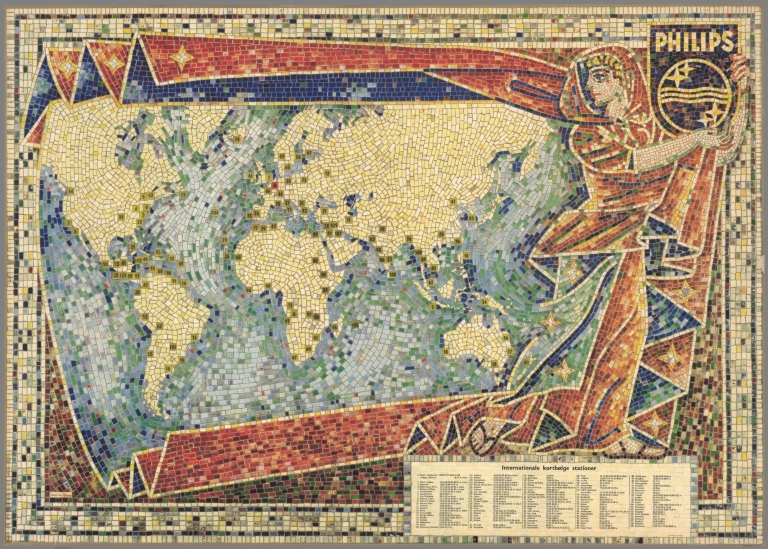COLLECTION NAME:
David Rumsey Historical Map Collection
Record
Author:
Roode, (Louis van), (1914-1964)
Date:
1953
Short Title:
Philips. Internationale kortbølge stationer.
Publisher:
J.D. Qvist & Komp. Akts.
Publisher Location:
Copenhagen
Type:
Separate Map
Obj Height cm:
77
Obj Width cm:
108
Note:
Date estimated.
World Area:
World
Subject:
Communications
Subject:
Pictorial map
Full Title:
Philips. Internationale kortbølge stationer.
List No:
10802.000
Publication Author:
Roode, (Louis van), (1914-1964)
Pub Date:
1953
Pub Title:
Philips. Internationale kortbølge stationer.
Pub Reference:
www.philipsreclamekunst.nl, n°35274344.
Pub Note:
"A superb and very rare advertising world map, drawn by the Dutch artist Louis van Roode (1914-1964) for the Dutch company Philips. This is a very original and unique map, drawn on a Greco-Roman mosaic background, unveiled and presented by a goddess holding in her hands the logo of the Philips company, depicting a shield displaying wavy lines, in reference to the sound waves traveling in the air, and star spangles, inspired by electric lighting, contained in a circle symbolizing the terrestrial globe. This emblem first appeared in 1938, and was registered in 1948. The map shows the 109 shortwave radio stations of the company Philips on the five continents. These stations, shown by a green square, are numbered and listed in a table at the bottom of the map, with for each city, the frequency band. One year after the official birth of television, Philips, today known as the Dutch giant of consumer electronics, started, in 1927, the production of radio receivers. In 1928, it began to broadcast abroad from short-wave stations with its international radio program, the Happy Station Show. The Dutch station is the only one marked with a red square on the map, numbered A, and called Radio Nederland (Happy Station). Philips was broadcasting in the most remote areas of the world, such as Wellington in New Zealand, as well as in the smallest, such as the Dutch island of Curaçao. We notice in the list of stations that some cities changed their name after 1960. We have in particular the city of Santo Domingo, which appears here under the name of Ciudad Trujillo, name which had been given to the city in 1936 in honor of the dictator Rafael Trujillo. The city regained its original name just after the assassination of the dictator in 1961. There is also the name of Hollandia, name carried until 1962 by the current Jayapura, capital of the Indonesian province of Papua. The map was published in 1953, and is listed on the site named Kunst in de Philips Reclame or Art in Philips Advertising (www.philipsreclamekunst.nl, n°35274344). Born in the city of Delft, south of the Netherlands, Louis van Roode was a sculptor, glass painter, wall painter, ceramicist and above all, a mosaicist. Strongly inspired by the famous mosaics of Ravenna in Italy, he made many mosaics for buildings in Rotterdam, mainly, but also in Groningen and Maastricht. Among his works are the war memorial at the Crooswijk General Cemetery in Rotterdam (1946), the glass mosaic for the post office at Rotterdam station (1958), the Britannia Hotel in Vlissingen and the Holbeinhuis building in Rotterdam (1954). He died in Rotterdam on February 19, 1964. (Begonia Le Bail, 2021)
Pub List No:
10802.000
Pub Type:
Separate Map
Pub Height cm:
77
Pub Width cm:
108
Image No:
10802000.jp2
Authors:
Roode, (Louis van), (1914-1964);
